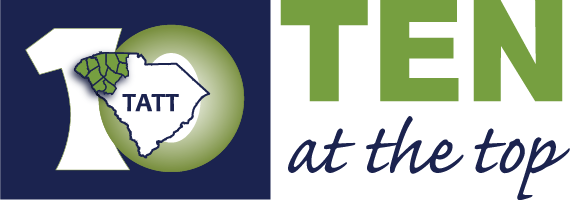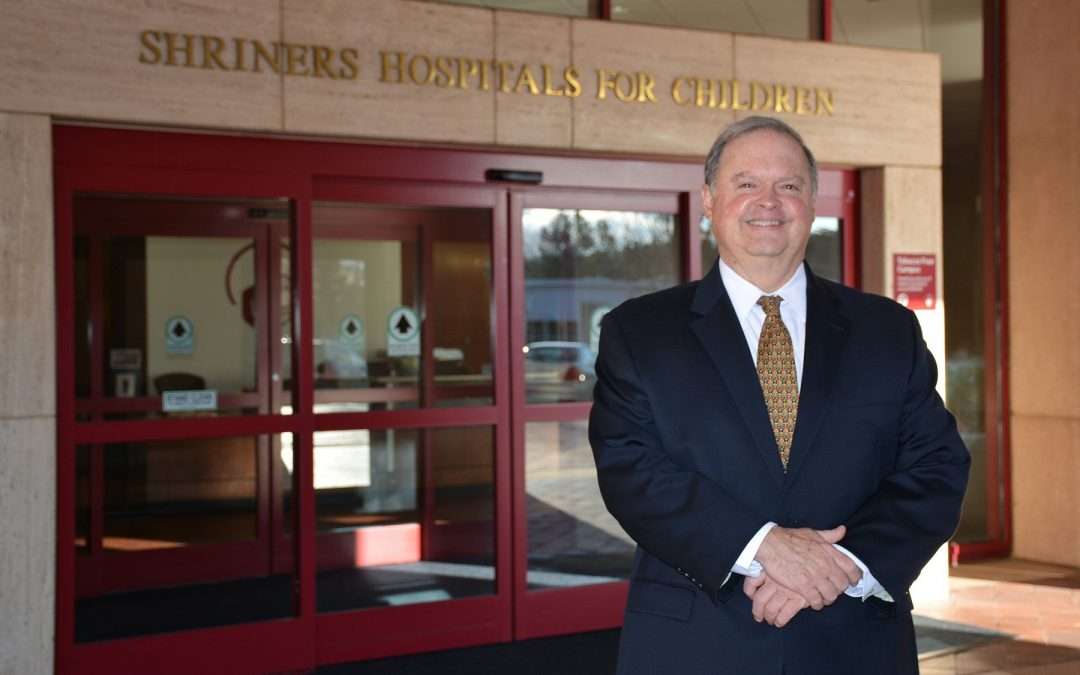
Jul 1, 2020 | Staying on Top, UpstateVibe365
with Sharon Purvis
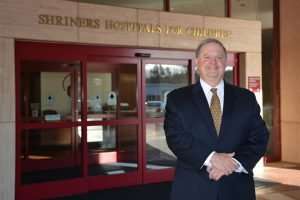
William Munley, Administrator, Shriners Hospital for Children of Greenville
Q: What is one challenge that you’ve faced during the pandemic that’s the same as other hospitals?
A: Even as a hospital specializing exclusively in pediatric orthopaedics, we faced great uncertainty regarding how the virus would play out. It was unknown whether or not our assistance would be necessary for other hospitals facing capacity issues; for that reason, like other hospitals, we postponed elective surgeries. However, while most surgical procedures at our hospital are not emergent—there were those that were time sensitive. For instance, our Mehta casting program helps children facing progressive infantile scoliosis—an aggressive curvature of the spine. Treatment is time sensitive, as infants and toddlers grow quickly, and the casting procedure is an involved process requiring the patient to go under anesthesia. Like other hospitals, it was important we identified surgeries that could wait and—equally important—those that could not.
Q: What’s a challenge that you’ve faced that’s unique to Shriners?
A: Our hospital’s catchment area covers six states: South Carolina, North Carolina, Alabama, Georgia, Tennessee and Virginia. During a time when travel is discouraged, the wide geography of our patient base creates a set of circumstances that most health care systems do not have to take into consideration.
Q: Many hospitals have placed restrictions on visitors and people accompanying patients, but I imagine it’s quite different in a setting where your patients are children. How have you handled this?
A: The emotional well-being of our patients is always something we consider, along with their physical health. In order to keep all of our children safe, we allowed each patient to be accompanied by only one parent or guardian. Recently, with sanitation and hygiene practices in full practice over the last few months, and a masking policy firmly in place, we re-evaluated and found that it was safe to expand our policy to allow two guardians to accompany our surgical patients. With every choice we’ve made along this winding road, the first question we’ve asked ourselves is: What is best for our patients?
Q: The Greenville Shriners Hospital is located on the same campus as Greenville Memorial Hospital. Is there a connection?
A: It is a common misconception that we are a part of Greenville Memorial Hospital; we are not. While we are located in a freestanding building on the same campus, we are a separate entity entirely. We do, however, enjoy a great working relationship with Greenville Memorial, and we utilize some of the talented members of the Prisma Health anesthesiology and radiology departments, as well as some subspecialists.
Q: Have you been able to continue offering all of your normal services and procedures, or were some of them pushed back because they’re considered to be elective procedures?
A: While telemedicine has been on our horizon for a while now, we used this time to fully launch our Fast Pass Virtual Visit service. As we worked to keep foot traffic in the hospital limited for the safety of those whose care required in-person service, this tool proved invaluable. Meanwhile, the needs of our other patients remained a paramount priority as well—and we were happy to provide them with the opportunity to visit with their nurse and doctor in the safety and comfort of their own home. In fact, many of our doctors felt that—with the ability to see and understand the home environment of their patients—they were able to offer even more personalized care.
Q: What do you want people to know about Shriners Hospital now, while so much focus is on COVID-19?
A: As things are opening up in the Upstate and across the country, there has been a rise in people testing positive for the coronavirus. However, we are proud to say we have not had one patient test positive. This has been through design, and hard work. Preventive measures, including screening questions, temperature checks, mandatory masks for all who enter the hospital and being vigilant about social distancing, have helped us achieve this standard. Additionally, we have employee “navigators” who stay with our patients and families to help them progress directly from our parking garage to their scheduled appointment room. Our entire staff is back to work, and all of our services are available again—including physical and occupational therapy, inpatient and outpatient surgery, outpatient clinic, motion analysis lab, and prosthetics and orthotics. As always, our multidisciplinary approach to care means everything is available under one roof; this eliminates the need for families to make multiple stops. We are extremely proud that the model we have had in place at the Greenville Shriners Hospital for decades could not be more relevant and appropriately designed to face the challenges we are experiencing right now in healthcare—and our world.

Jun 24, 2020 | Staying on Top, UpstateVibe365
There are eight towns across the Upstate that have Main Street associations, which exist to encourage economic development as well as historic preservation of downtowns. Those associations, working in tandem with local Chambers of Commerce and their city officials, have worked hard to support their downtown businesses during the shutdown and as things have begun to open up. We asked them to tell us about some specific ways that their businesses have engaged the community, supported each other, and have been successful in spite of the tremendous hardship of the pandemic.
Here are some of their responses, and we’ll share the others with you next week, in Part 2.

Katherine Brooks, Main Street Central
Katherine Brooks, Central
Central’s Main Street district is a relatively small area, but we have seven small businesses that had been open for less than a year when the shutdown began. A few businesses chose to do exterior improvements during this time, and were able to take advantage of the town’s facade improvement grant. Before restaurants were allowed to reopen, town passed an ordinance allowing sidewalk seating and outdoor alcohol sales, and created extra partitioned off seating areas to allow business to have as much customer seating as possible. Restaurants adapted by promoting take out, online ordering, and delivery, and a women’s boutique has had great success with online sales and curbside pick up.
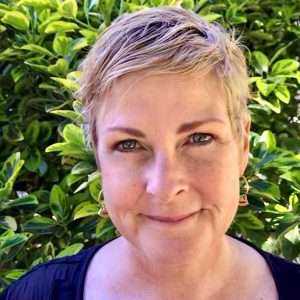
Libby Imbody, Main Street Walhalla
Libby Imbody, Walhalla
I started my new position in a new Main Street program about two weeks prior to the COVID-19 shutdown. Even before the outbreak, I knew one of my greatest tasks would be to develop and cultivate a stronger sense of community within our downtown businesses. As small as our town is, most shop owners barely knew each other and rarely communicated. The early days of shutdowns and emergency declarations brought a lot of fear and confusion. Navigating both the health and financial issues that seemed to change daily put an unbelievable amount of stress on business owners. I think the true silver lining of this pandemic has been how our business community has united. From cross-promotions to watching each other’s stores to ordering countless take-out dinners from each other, the merchants of Walhalla have amazed me in how quickly they have been able to pull together during the toughest of times. As a business community, we have all improved our resilience, ingenuity, and empathy in the last three months. Entrepreneurs, in general, have a superpower of unlimited hope, and the small business owners of Walhalla are no exception. I truly look forward to what the future of our town holds.
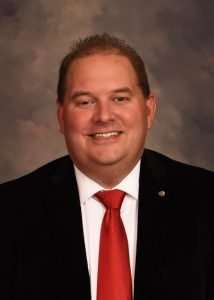
Jonathan Irick, Main Street Laurens
Jonathan Irick, Laurens
When our downtown district was faced with the shutdown, our Main Street SC network became the most active I think it has ever been. We shared a lot of information to our businesses to help them as much as possible. Here in Laurens, we had two businesses in particular who handled the shut-down in successful ways.
Roma, one of our downtown restaurants, unfortunately had to let about 50% of their staff go. However, they took the opportunity to begin offering take-out with curbside pick up and delivery options. They also extended their hours during the day to offer more opportunities to support them. Along with the changes in business model, Yvan Youseff, the owner, and his staff took the down time to repaint the facade of the business, paint the interior and do an overall re-fresh inside and out. Coming out of the shut-down they were able to hire back at least two of the staff and are looking at new additions to their menu.
Similarly, Southern Twist, a boutique in downtown, took to social media to post sales and held a Facebook Live event. They also offered curbside pick-up during the shutdown. Recently, Christie Finley, the owner, reported that she actually saw an increase in her overall sales during the shutdown.
These two success stories demonstrate how our community rallied around our small businesses and helped support them during the COVID-19 shutdown.

Lara Hudson, Uptown Greenwood
Lara Hudson, Greenwood
Uptown Greenwood is very fortunate to have a very rich and diverse music scene. Most any night you can find live music at one of the restaurants or bars in our district. So when the COVID-19 pandemic began and our restaurants and bars were forced to close for indoor dining, not only were those businesses struggling to stay afloat, but our local musicians found themselves with no venues to perform in and no income. Several local business owners and musicians recognized what was happening and quickly created two projects that have been huge successes.
The first was designed to help local restaurants, their staff, and the musicians financially as well as give the community the live music they craved. The “Until Further Notice” campaign consisted of live virtual concerts steaming each night at 7:00 pm on Facebook. The original plan was for 2 weeks but this project is still going strong and you can find live music every Friday and Saturday streaming from our local community theatre on the Howetown Hodges Stay at Home Tour Facebook page. This project allowed for the musicians to post a virtual tip jar and viewers could donate online. A local printer also designed and printed #teamgreenwood t-shirts for the businesses to sell, and 100% of the proceeds benefited the restaurants and their staff.
The second project was a virtual performance of “American Pie” (aka “The Day the Music Died”) involving over 30 local musicians performing the Don McLean classic together, but separately. The video was produced locally by several musicians and videographers who donated their time and efforts. McLean himself gave permission for this video version of his song and generously waived any fees, requesting only a video of the finished product, and he shared the video on his Facebook page. The video can be viewed here. Make sure you look for Greenwood’s own Mayor Brandon Smith.
Uptown Greenwood, like countless communities across the state and nation, continue to face the challenges of doing business in the world-changing pandemic. Greenwood will survive this because of the strong sense of community.

Jun 24, 2020 | Staying on Top, UpstateVibe365

Dean Hybl, Executive Director, Ten at the Top
While cities, counties, businesses and organizations across the Upstate continue to address public health and economic issues related to the global pandemic, Ten at the Top remains committed to serving as a regional convener and connector to help support local efforts and grow the Upstate’s collective capacity.
To help better understand the concerns and challenges being faced by communities across the Upstate, Ten at the Top recently completed a virtual “Listening Tour” of the seven non-urban counties in the region (all counties except Anderson, Greenville and Spartanburg). Each session included input from leaders from local governments, community organizations, businesses and other local stakeholders.
While each county had its own nuances and distinct approach to responding to the pandemic, there were a number of similarities across the region.
Most encouragingly, each county reported that overall the response to provide needed services to those facing immediate hardship has been successful in meeting the general needs of all residents, including children, seniors and college students. Another commonality has been a collaborative spirit as many local entities, including some that had not previously worked together, have collaborated to meet the needs of local residents.
Communication has been an important element and communities have used a variety of methods to ensure residents are aware of programs as well as health services. Social media has played an important role in many communities, but with a significant portion of residents in rural counties not serviced by high speed internet, that approach has not reached all residents.
Accessible and affordable internet was a theme across the region. In some communities, school buses were deployed to help residents connect to internet, especially to assist students. However, with transportation also an issue for some residents, reaching an internet hot spot was not always possible.
With many businesses shut down for an extended period of time due to the stay at home order issued by Governor McMaster, there is great concern about how quickly small businesses can recover. Many communities have worked with business service agencies to help ensure their business owners are able to connect to government support programs developed to reduce the impacts on local businesses. In addition, many local business organizations have been providing marketing and promotional support for local businesses.
One interesting commonality among the communities is that while COVID-19 has spotlighted issues including internet accessibility and fragility of small businesses in rural communities, there are also a number of issues that were of concern prior to COVID-19 that remain priorities across the Upstate.
Mobility and lack of transportation access has become a regional priority in recent years, especially for many residents of rural communities who are unable to improve their personal economic mobility due to lack of access to transportation. Skill training also remains an issue in many Upstate counties as the technical colleges, Workforce Boards and others continue to provide a critical service to help people gain skills needed for higher paying jobs.
During each session, members of the Ten at the Top team asked a specific set of questions around the topics of general collaboration, economic development & small businesses, infrastructure & mobility and social services, public health and education. You can read each of the county specific summaries through this link.
Next Steps & Future Opportunities
In general, the listening tour input reinforced that a number of the areas in which Ten at the Top has been focusing collaborative efforts—including mobility & transportation, entrepreneur support and senior needs—remain relevant during the current crisis.
Access to internet & broadband technology was also a major focus, and while Ten at the Top will certainly support the continued expansion of availability across the region, that issue seems to have been identified as a state-wide issue that the state legislature will be focusing to address.
Below are some of the specific follow-up actions that TATT will be taking in the coming weeks to support the issues identified during the listening tour:
Rural Mobility Listening Session: The Upstate Mobility Alliance’s Moving People Task Force will be holding a special virtual listening session on July 13th with representatives from rural communities to better learn about specific mobility & transportation challenges in the non-urban areas within the Upstate. Following this session, the committee will develop a strategy for how to move forward in supporting greater access to transportation in the rural areas within the Upstate.
Entrepreneur & Small Business Webinar Series: To help address some of the specific challenges identified by entrepreneurs and small businesses, TATT’s Upstate Entrepreneur Ecosystem group will be holding a series of webinars with subject experts that will be available for viewing by small business owners and entrepreneurs. In addition, the group will continue to focus on “connecting the disconnected” with resources to help start and grow businesses in the Upstate.
Senior Needs Workshops: Due to COVID-19, TATT has been unable to hold in-person Senior Needs Workshops through the first half of 2020. Beginning in August, we intend to hold virtual workshops to continue to connect senior service providers and to especially understand how to support their needs during the current pandemic.
In addition to these three specific efforts, TATT will continue to look for opportunities to support communities across the Upstate in other areas that are impacted by the pandemic and corresponding economic crisis.

Jun 24, 2020 | Staying on Top, UpstateVibe365
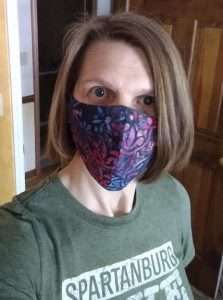
Sharon Purvis, sporting a handmade mask
by Sharon Purvis, Director of Outreach and Special Projects, Ten at the Top
The accessory we never knew we needed is the thing that will help keep the spread of COVID-19 at bay as we go back to work and other activities that require us to be around people: the mask. Nobody really loves to wear them, but masks will be part of our lives for the foreseeable future.
In the beginning of the outbreak, there was a huge need for masks at hospitals, and people hauled out their sewing machines to make masks for hospitals, in addition to numerous Upstate manufacturers pivoting to PPE assembly for frontline workers.
This week, the city of Greenville passed an emergency ordinance requiring masks in pharmacies and grocery stores, and SC education superintendent Molly Spearman said in a statement that mask use now is key to schools opening in the fall.
As it has become apparent that widespread mask use is necessary to fight the virus, a cottage industry of homemade masks has sprung up. While some larger employers provide masks for their workers, many of us, if we’re not crafty enough to make our own, have to figure out where to get a mask.
A quick search on Etsy.com turns up pages and pages of mask options, and the email I got from my local farmers market lists a woman selling masks as one of the vendors. My Facebook feed includes ads for masks from national brands. Here in our office, we’re all wearing handmade masks—two of us purchased them from a friend of mine who makes them, and the other two wear masks made by family members.
A Local Option with a Social Impact
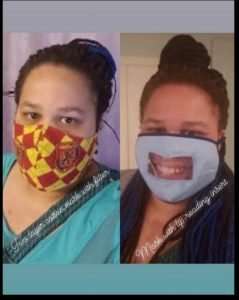
Latria Graham of Covering America: The Face Mask Initiative, modeling two of her masks
Spartanburg freelance writer Latria Graham and her mother Melinda started sewing masks after Latria stopped into a store near their home at the beginning of the pandemic and saw workers there without PPE of any kind. She talked it over with her mom, and they decided they would start making masks for people they encountered who needed them. Melinda is a fashion designer who has been sewing for more than 50 years, and Latria is a hobbyist and who sews for her cosplaying—so they were well up to the challenge.
“We knew the people that were going to be hit the hardest by this were those without the time, money, resources, and/or skills to acquire a mask, so that’s where we are focusing right now,” Latria says. Covering America: The Face Mask Initiative was born.
In the months since they started, the mother/daughter duo have made more than 700 masks, churning out 25-40 masks a day. Initially, the masks were made from fabric they had on hand at home, but after using up their own supplies, Latria turned to the internet for assistance, starting a GoFundMe for help paying for fabric, elastic, and ribbon for the masks as well as postage for shipping masks to groups out of state such as the Navajo Nation, which has a large number of COVID-19 cases.
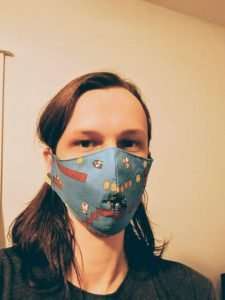
Because of Latria’s interest in cosplaying, a lot of her fabric is related to various fandoms, which make great masks for kids! This one is made from Super Mario Brothers fabric.
“Most of the people in my life are essential workers. I know you can’t pick peaches or process meat over Zoom, and we’re an industrial and agricultural state,” Latria says. “So we’re doing our best to reach those people too, even though they aren’t considered frontline workers.”
In addition to the GoFundMe, Latria is offering a buy one/donate one option for those who want to purchase masks—$12 for a child/youth mask and $15 for adults/plus size. She also offers masks with a clear insert to allow for lip reading for those who live or work with the hard of hearing.
Requests for masks can be made using this form, and you can email Latria for the purchase/donate option.
Bulk Masks for Corporate Use
At work, it’s not a given that everyone will have their own masks, so employers may need to provide them for their workers. Cintas in Spartanburg, which supplies all kinds of workforce apparel, has around 80,000 disposable surgical masks in inventory, says general manager Mark McKinney. A box of 50 masks sells for $40, and prices can be negotiated for larger bulk purchases. Contact Mark for details.

Jun 17, 2020 | Staying on Top, UpstateVibe365
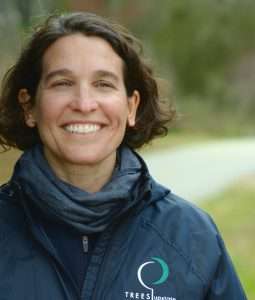
Joelle Teachey, Executive Director and Arborist, TreesUpstate
by Joelle Teachey, Executive Director and Arborist, TreesUpstate
We have all felt the impact of COVID-19 in various ways.
TreesUpstate, formerly known as TreesGreenville, was founded in 2005. Our mission is simple: to plant, promote, and protect trees. All of our work is mission based and the direct services we provide to the Upstate are rooted in planting and maintaining a healthy tree canopy.
We plant trees in parks, schools, and neighborhoods.
We promote the public health, social, economic and environmental benefits of trees.
We protect trees through forest restoration, by providing technical support, and by training industry professionals on best management practices.
Why trees? Trees cool and clean the air. Shade trees reduce the formation of ground level ozone. Trees help us stay in attainment of National Air Quality Standards. Trees reduce stormwater runoff. Trees are quietly working hard for us every day.
During these unprecedented times we have shifted, adapted and prioritized. Our most pressing priorities are: 1). taking care of our trees, 2). planning our next planting season that begins in October, 3). rescheduling our postponed TreesUpstate’s Energy Saving Trees Giveaways presented by Duke Energy, and 4). planning our 12th annual TreesUpstate Turkey Day Run on Thanksgiving morning.
TreesUpstate is planting and maintaining a healthy urban and community forest which requires time, commitment, understanding, expertise, staff, and funding. Staff and funding is where TreesUpstate has been impacted the most. This past spring we were going to launch a very specific public tree planting campaign to raise funds to plant and maintain trees along a popular Greenville destination. The launch of this tree planting campaign didn’t seem right in the midst of a global pandemic. Stay tuned. When the time is right you’ll learn about how you can get involved. Looking ahead, community support will be critical for TreesUpstate to continue to provide direct urban forestry services that positively impact the entire Upstate.
During the past few summers we’ve had a Youth Tree Care Crew that watered, weeded, mulched, fertilized, and pruned trees that TreesUpstate planted along the Prisma Health Swamp Rabbit Trail, at Greenville County Schools, and in Greenville County parks and greenspaces. Because of social distancing guidelines we were unable to hire a Youth Tree Care Crew. It didn’t seem right to have a group of teenagers driving around in a truck together this summer. Our newly planted trees still need to be watered though. And our trees still require maintenance. As a solution we’ve installed hydration systems on our newly planted trees and hired a seasonal Tree Care Technician to help care for our trees this summer.
Despite COVID-19 TreesUpstate is still here. TreesUpstate raises every $1 we have. Thanks to all of our Corporate Partners, Turkey Day 8k Sponsors & runners, donors, and volunteers, we have planted and given away over 16,000 trees! Together, we are making a difference.
Lastly, as an arborist I feel compelled to give you a few quick takeaways:
- We get benefits from mature trees.
- We have to properly plant and maintain trees so they live to maturity.
- The most common mistakes we see are that trees are NOT being properly planted and maintained. And this is very, very, common.
- A properly planted tree should show its trunk flare and its first main lateral root at or slightly above ground level.
- Mulch should only be 2 to 4 inches deep and it should never touch the trunk of a tree.
- Trees should never be topped (the only exception is utility pruning).
Learn more about us at TreesUpstate.org

Jun 17, 2020 | Staying on Top, UpstateVibe365

Terence Roberts, Mayor of Anderson and Chair of Ten at the Top
by Terence Roberts, Mayor of Anderson and Chair of Ten at the Top
I was born in 1959 and was the oldest son of William and Linda Roberts. They were black educators at Westside High school in Anderson. As a little black boy growing up in the segregated south, I have vague memories of watching on television the civil rights protests, Vietnam War, the assassinations of Dr. Martin Luther King Jr and John F. Kennedy. So for me there were moments that I could sense my parents’ uncertainty about the future.
Although we have come so far in the last sixty years, our country continues to struggle with the issue of safety. We all want to live in communities that are safe and vibrant. We still have many neighborhoods in the Upstate in which this is not the case. Over the last few months I have often wondered what will be the vague memories of my grandchildren.
I believe it is time to speak up. If deeply cherished values are not to degenerate beyond all recall, apathy must cease. People are aware, of course, that harmful changes are taking place in our society both in attitudes and values. But nobody wants to talk about it. We see the greed and materialism going on in so many aspects of our daily lives and we say nothing. We hear about and see on television the extreme violence and protests that are taking place in large cities and in our small towns. The public outcry in the Upstate will continue unless we take immediate action.
It is time for us to stand up for what we believe in. This is a local issue. I have proposed that Ten at the Top should convene a regional exploratory committee consisting of local government leaders, law enforcement officials, community & business leaders as well as members of our faith community to discuss opportunities to create a united Upstate region where all stakeholders work collaboratively to ensure that we foster a culture that respects and values the lives of our law enforcement officers and all residents. This committee will ask questions, look at best practices and seek guidance. Then my hope is that we form core beliefs and stick to them. Of course, we all must be open for compromise, but remember the old saying, “if you don’t stand for something, you’ll fall for anything.”
There is an anonymous folk saying which goes, “We ain’t what we want to be, we ain’t what we’re gonna be, but thank God we ain’t what we was.” None of us can have the luxury of stopping and sitting down where we are as if our work on this earth is done. We must learn from our past mistakes and press on to greater achievements. In these uncertain times, we must strive to be able to move through pain, anger, doubt, and fear without missing a step!


